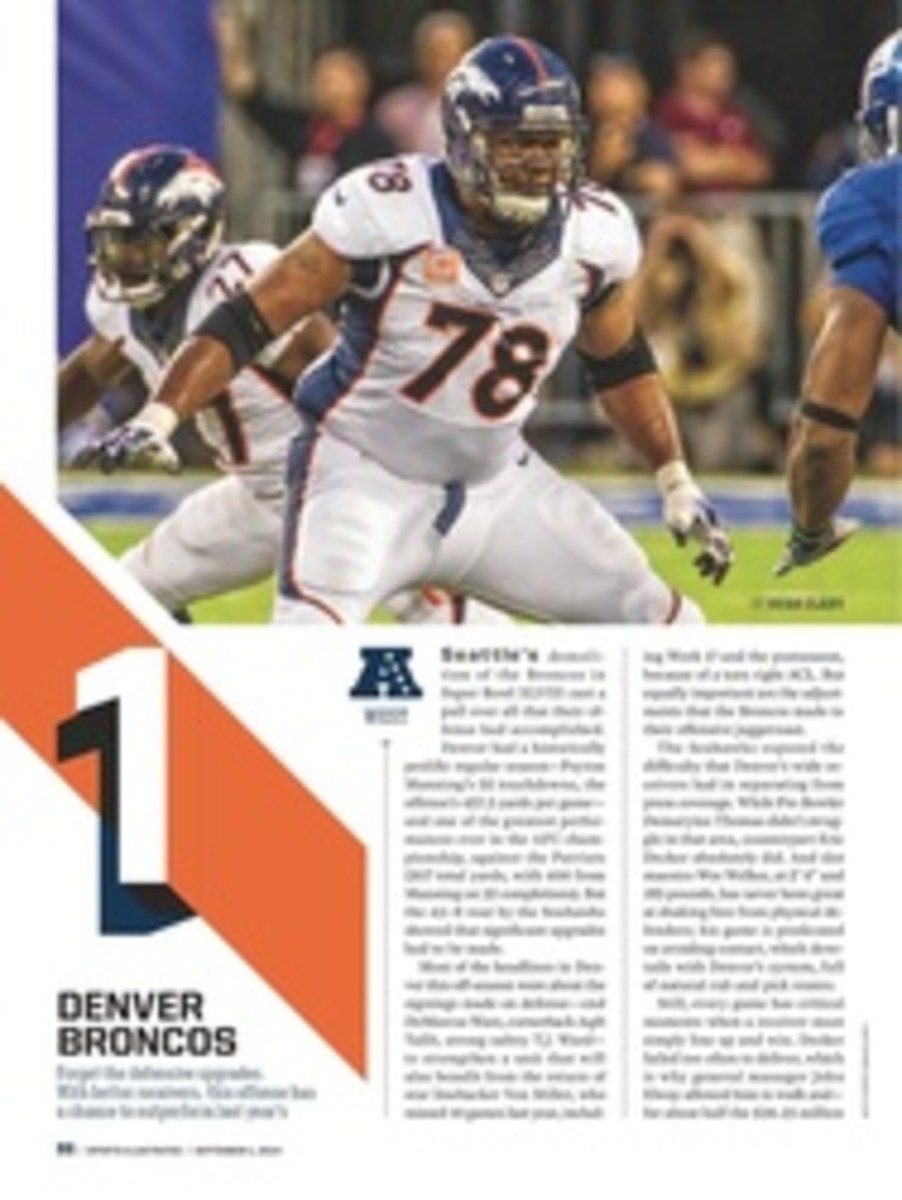
1 PHILADELPHIA EAGLES
The fascination with coach Chip Kelly's cutting-edge offense and the amazement over first-year starter Nick Foles's NFL-high passer rating (119.2) diverted attention from what actually drove the Eagles to the NFC East title last season: outstanding defense. Only two teams, the Vikings and the Saints, scored more than 22 points against Philadelphia after September.
In fact, of the two units, Philly's defense has the more diversified approach, fulfilling a mandate that Kelly (who's not a defensive guy) gave coordinator Billy Davis upon his hiring last year. Many of the offense's plays are essentially the same, just wrapped up in different looks. What Davis implemented is a hybrid scheme with a wealth of pass-rush concepts out of 3--4 and 4--3 fronts, as well as out of a nickel sub package. The idea is not just to get sacks—though the Eagles presumably hope to improve on their modest 37 takedowns from 2013—but rather to pressure QBs into bad decisions and errant throws.
In this respect the unit's performance was better than it may have seemed. Philly's pass defense allowed the most yards in the NFL, 289.8 per game, but that was the direct result of the offense's accelerated tempo, which put the D on the field for more snaps than any other team's: The Eagles faced a league-high average of 41.9 passes. In yards yielded per attempt, though, they ranked a far more respectable 19th (7.3 yards).
There's still room to improve, of course. And Philadelphia has the personnel to do so. Inside linebackers DeMeco Ryans, a sturdy run defender, and Mychal Kendricks, a developing cover guy, both blossomed as blitzers last season. They're joined by a collection of quality pass rushers: Trent Cole, who is 31 but can still play at a high level, thanks to a natural sense for leverage; Marcus Smith, a first-round pick out of Louisville; Brandon Graham, a vastly underappreciated rotational force who plays with a strong blend of speed and leverage; and Vinny Curry, a 2012 second-rounder with a surprising burst given his build (6'3", 279 pounds).
Connor Barwin can ably rush the passer, too, but he's also tremendous at peeling out to handle running backs in coverage and at jamming tight ends or receivers off the line. That's crucial because one of Davis's core principles involves double-teaming an opponent's top receiver. To that end, Philadelphia signed Saints free agent Malcolm Jenkins to a bargain three-year, $15.5 million contract ($8.5 million guaranteed). The rangy free safety can patrol deep and, having entered the NFL as a first-round cornerback in 2009, is comfortable playing man coverage in the slot. If he does align there, it could be an indication of a blitz, something he thrived at under Rob Ryan last year. Coveragewise, the Eagles already have what might be the league's best young slot artist in Brandon Boykin.
At the corners, Bradley Fletcher and Cary Williams form the league's most improved tandem. Early last season those two played only in conservative off-man coverage, and offenses ate them up. But as time went on, they played more man-to-man looks. They thrived, which expanded the schematic possibilities for the rest of the unit.
In many respects a defense is only as good as its ability to stop the run, and here Philly can be stout, assuming Ryans and Kendricks are sharp behind what should be a disruptive front line. Many pundits expected 2012 first-round pick Fletcher Cox to emerge as the front's best defender. While he's shown flashes and been serviceable, he's failed to be the high-octane every-down force they expected. Cedric Thornton, an undrafted free agent out of Southern Arkansas in 2011, has actually been more impressive. Like so many other members of the Eagles' defensive-line rotation, Thornton can slide inside and play nosetackle (or shade off the nose), though he inflicts most of his damage from his natural five-technique (defensive end) spot, where he's beastly against the run.
Given Kelly's breakneck offensive pace, opponents often want to run the ball to rest their defense. And because of that, Thornton and Cox (plus ascending second-year nosetackle Bennie Logan) could determine how successful Philadelphia's D will be. With scheme diversity and depth at all three levels, expectations are high.
2014 SCHEDULE
2013 Record: 10--6
WEEK 1
JAX [HOME]
IND MON [AWAY]
WAS [HOME]
SF [AWAY]
STL [HOME]
NYG [HOME]
BYE
ARI [AWAY]
HOU [AWAY]
CAR MON [HOME]
GB [AWAY]
TEN [HOME]
DAL THUR [AWAY]
SEA [HOME]
DAL [HOME]
WAS SAT [AWAY]
NYG [AWAY]
WEEK 17
FOCUS ON
The offensive line
Want to know a big reason LeSean McCoy, the league's most agile runner, and Darren Sproles, a terrifying run-catch threat, will have big seasons? Because they play behind an offensive line that's perfectly suited to the Eagles' scheme. In a fast-paced, space-oriented system that relies on lateral movement to exploit the field's full 531/3-yard width, you need mobile, athletic blockers. In those terms left tackle Jason Peters has long been one of the league's best. Evan Mathis became a top-shelf left guard because of his feet. Right guard Todd Herremans is not as agile but makes up for that with his savvy. Right tackle Lane Johnson spent two years playing tight end in college and was drafted with the No. 4 pick last year explicitly because of his raw athleticism. And in the middle of it all is Jason Kelce, who gets out in front on screens and elongated runs as effectively as any center in the game. McCoy and Sproles will be the ones collecting all of the fantasy points, but this fivesome deserves a high percentage of the credit.
THE CASE FOR
Quarterback Nick Foles
The designation system quarterback, like game manager, has become a pejorative. But wouldn't it mean something to be the best system quarterback in the NFL? Entering his third season, Nick Foles has a chance to be exactly that, despite having only decent arm strength and a palpable discomfort throwing with bodies around him. His impressive 2013 numbers—a league-high 9.1 yards per attempt, along with 27 touchdowns and just two interceptions in 10 starts—can be attributed largely to coach Chip Kelly's scheme. Being a great system QB obviously requires having a great system. Kelly, with his sense for field balance and for rapid, unconventional play-calling, provides that. The system does not require big-time weapons—hence the release of headache DeSean Jackson. It just needs speedsters who can make plays in space. Many of Kelly's route combos paint a straightforward picture of progression reads for the passer. Still, not every QB can see that picture clearly and exploit what he sees. Even though Foles is not mobile enough to scare teams in the scheme's patented read-options (which Kelly has cut down on), he can be an excellent orchestrator by continuing to play with patience and discipline.
PHOTO
CHRIS HUMPHREYS/USA TODAY SPORTS
DE CEDRIC THORNTON
PHOTO
JED JACOBSOHN FOR SPORTS ILLUSTRATED
NINTEEN PHOTOS

